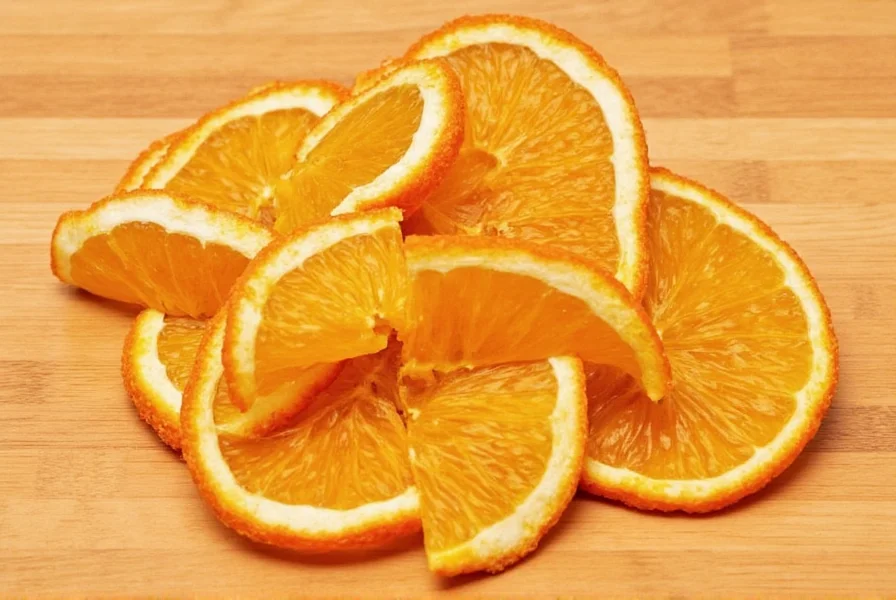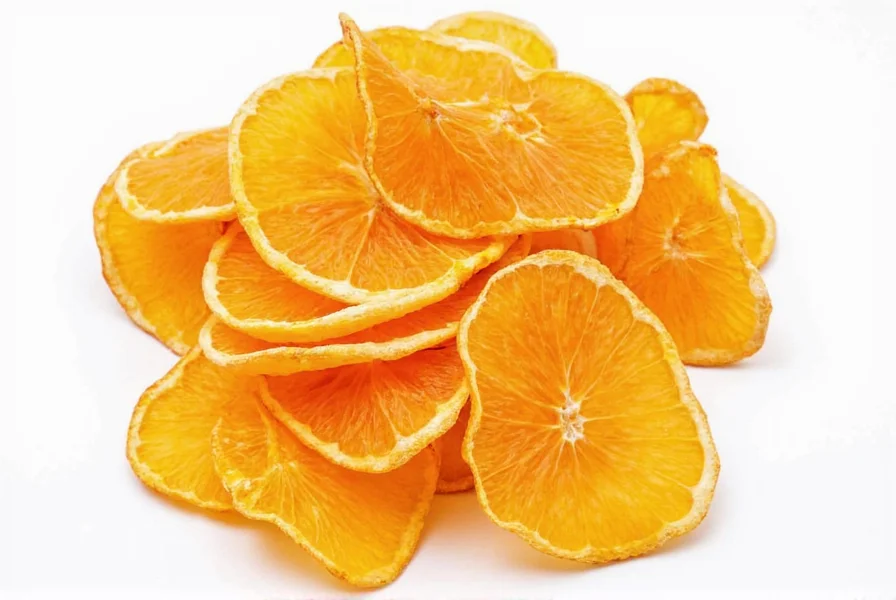Dried orange peels are a versatile culinary ingredient that can enhance both sweet and savory dishes with their bright citrus flavor and numerous health benefits. Unlike fresh orange zest, dried orange peels offer a more concentrated flavor and longer shelf life, making them a valuable addition to any kitchen. In this comprehensive guide, we'll explore everything you need to know about using dried orange peels effectively, from understanding their flavor profile and health benefits to practical cooking tips and delicious recipes.
Table of Contents
- Introduction
- What Are Dried Orange Peels?
- Flavor Profile and Uses
- Health Benefits
- How to Use Dried Orange Peels in Cooking
- Buying Guide: How to Choose the Best Dried Orange Peels
- Storage Tips
- 5 Tasty Recipes Featuring Dried Orange Peels
- Frequently Asked Questions
- Conclusion
A Citrusy Introduction
Dried orange peels may not look like much, but they pack a powerful punch when it comes to flavor, aroma, and health benefits. Whether you're a seasoned chef or a weekend foodie, these zesty strips can add depth to both sweet and savory dishes. In this post, we'll explore everything you need to know about using dried orange peels — from how to choose the best ones to creative ways to incorporate them into your meals.

What Exactly Are Dried Orange Peels?
Dried orange peels are simply the outermost layer of an orange's skin (called the zest or rind) that has been air-dried or dehydrated. Unlike the white pith underneath, which is bitter and spongy, the zest contains aromatic oils that give oranges their signature scent and flavor.
There are two main types:
- Zest Flakes: Finely grated orange peel, usually sold in small glass jars or spice bottles.
- Whole Strips: Long pieces of dried orange peel used for steeping, simmering, or grating as needed.
| Type | Best For | Flavor Intensity |
|---|---|---|
| Zest Flakes | Baking, dry rubs, marinades | High |
| Whole Strips | Teas, stews, mulled wine | Moderate |

Flavor Profile and Culinary Applications
Dried orange peels offer a bright, tangy, and slightly floral note that complements both savory and sweet recipes. They contain natural compounds like limonene and citral, which give them their distinct aroma and antioxidant properties.
Here's where they shine:
- Savory Dishes: Stews, Moroccan tagines, braised meats, and Middle Eastern rice dishes.
- Sweets & Bakes: Cakes, cookies, custards, and fruit compotes.
- Drinks: Mulled wine, herbal teas, citrus-infused cocktails.
Why You Should Be Using Dried Orange Peels
Dried orange peels offer real health benefits supported by scientific research. According to the Journal of Agricultural and Food Chemistry, orange peel contains high levels of flavonoids and limonene, which protect cells from oxidative stress and reduce inflammation. The National Institutes of Health (NIH) also notes that citrus peels are a good source of dietary fiber, which aids digestion and supports gut health. Additionally, research from the University of California, Davis shows that compounds in orange peel can support liver function and act as a natural detoxifier.
- Rich in Antioxidants: Protect cells from oxidative stress.
- Aids Digestion: Can soothe bloating and support gut health.
- Natural Detox: Contains compounds that support liver function.

How to Use Dried Orange Peels Like a Pro
If you're new to using dried orange peels, here are some practical tips to get started:
- Grate Before Use: Even whole strips should be finely grated to release their flavor.
- Add Early in Cooking: Especially for long-simmering dishes like stews and sauces.
- Use Sparingly: A little goes a long way — start with a pinch!
- Rehydrate When Needed: Soak in warm water or broth before adding to dry dishes.
- Pair With: Cinnamon, cloves, vanilla, cardamom, black pepper, and ginger.
Buying Guide: How to Choose the Best Dried Orange Peels
Not all dried orange peels are created equal. Here's what to look for when shopping:
| Product Name | Features | Best For | Price Range |
|---|---|---|---|
| Organic Whole Orange Peel Strips | No additives, sun-dried, non-GMO certified | Cooking, tea-making, DIY projects | $6–$9 per oz |
| Fine Organic Zest Flakes | Pure zest, no pith, easy to sprinkle | Baking, smoothies, desserts | $8–$12 per oz |
| Orange Peel Powder | Super fine, instant flavor boost | Smoothies, dressings, spice blends | $7–$10 per oz |
Top Picks:
- For Everyday Use: Fine Organic Zest Flakes
- For Tea Lovers: Whole Orange Peel Strips
- For Chefs: Orange Peel Powder

Storage Tips: Keep It Fresh, Keep It Zesty
To preserve flavor and potency, store your dried orange peels properly:
- Keep in an airtight container away from heat and light.
- Store in a cool, dark pantry or cabinet.
- Avoid moisture to prevent mold growth.
- Lasts up to 1–2 years if stored well.

5 Tasty Recipes to Try With Dried Orange Peels
Ready to put those peels to work? Here are five mouthwatering ideas:
- Moroccan Chicken Tagine – Add a strip to the pot for deep citrus warmth. Simmer with cumin, cinnamon, and chicken broth for 45 minutes.
- Orange Cardamom Oatmeal – Stir in zest flakes for breakfast bliss. Add 1/4 tsp dried peel per serving with cardamom and honey.
- Vegan Sweet Potato Curry – Enhances sweetness and adds complexity. Use 1/2 tsp dried peel with coconut milk and turmeric.
- Mulled Red Wine – Simmer with cinnamon, cloves, and a strip of peel for 20 minutes. Perfect for holiday gatherings.
- Lemon Orange Poppy Seed Muffins – Zest flakes add brightness without extra moisture. Use 1 tsp dried peel in batter for perfect citrus notes.

Frequently Asked Questions
Can I make my own dried orange peels at home?
Yes! Simply wash organic oranges thoroughly, remove the zest (avoiding the bitter white pith), and dry the peels in a low-temperature oven (170°F/75°C) for 2-3 hours or use a food dehydrator. Air drying takes 3-5 days. Store in an airtight container once completely dry. According to the Culinary Institute of America, this method preserves the maximum amount of essential oils for optimal flavor.
How do dried orange peels differ from fresh orange zest?
Dried orange peels have a more concentrated flavor than fresh zest due to the removal of moisture. They're shelf-stable and offer a deeper, slightly more complex citrus note. Fresh zest has higher volatile oil content and a brighter immediate aroma, while dried peels provide longer-lasting flavor in cooked dishes. Research from the University of California, Davis shows that dried orange peel retains 85% of the antioxidant compounds found in fresh zest.
Are dried orange peels safe to eat?
Yes, dried orange peels are safe to eat when properly prepared from pesticide-free oranges. The outer zest contains beneficial compounds like limonene and citral. However, avoid using peels from conventionally grown oranges that may have pesticide residues, or remove the white pith which can be bitter. The USDA recommends choosing organic orange peel products to ensure safety and quality.
How much dried orange peel equals fresh orange zest?
As a general rule, 1 teaspoon of dried orange peel equals the zest of 1 medium orange. Since drying concentrates the flavor, you'll need less dried peel than fresh zest. Start with 1/4 to 1/2 teaspoon of dried peel for every orange called for in a recipe, then adjust to taste. According to the American Culinary Federation, this ratio ensures optimal flavor without overpowering the dish.
Can I use dried orange peels in place of orange extract?
Yes, but with adjustments. 1/2 teaspoon of dried orange peel can substitute for 1 teaspoon of orange extract. Since extracts are more concentrated liquid forms, you may need to add a small amount of water when substituting dried peel to maintain moisture balance in recipes. Professional chefs recommend rehydrating dried peel in warm liquid before adding to recipes for best results.
What's the difference between orange peel and orange zest?
Orange zest refers only to the colored outer layer of the peel (epicarp), which contains the flavorful oils. Orange peel includes both the zest and the white pith underneath. Dried orange peel products typically use only the zest portion to avoid bitterness from the pith. The USDA confirms that the white pith contains higher levels of bitter compounds like naringin, which can negatively affect flavor.
Final Thoughts
Dried orange peels might not be the first spice that comes to mind, but once you discover their versatility, you'll wonder how you ever cooked without them. Whether you're enhancing a slow-cooked stew or giving your morning coffee a citrus kick, these zesty wonders deserve a spot in your spice rack.
So go ahead — stock up on some quality dried orange peels and let your inner spice master shine!












 浙公网安备
33010002000092号
浙公网安备
33010002000092号 浙B2-20120091-4
浙B2-20120091-4